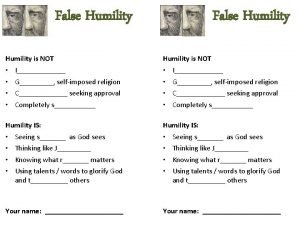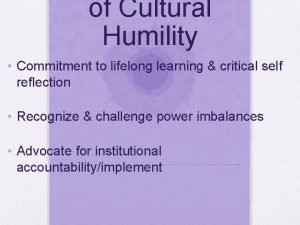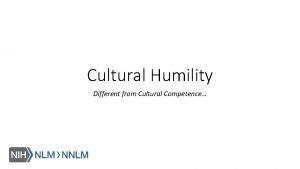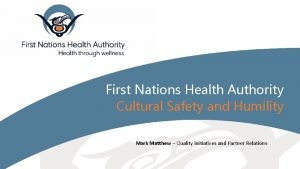of Cultural Humility Commitment to lifelong learning critical







- Slides: 7

of Cultural Humility • Commitment to lifelong learning & critical self reflection • Recognize & challenge power imbalances • Advocate for institutional accountability/implement

Dimension 1: Lifelong learning & Critical Self Reflection For the Practitioner: • Understanding your own story • Naming & owning your own identity • Reflecting on and acknowledging cultural & family history, personal biases • Inventorying both privileges & struggles, strengths & vulnerabilities • In what ways do I experience power and privilege? In what ways do I experience discrimination and disenfranchisement? What assumptions do I have about this patient’s culture? What might be my limitations in serving this patient (what I don’t know or think I know)? What might be my strengths in serving this patient? • Commitment to lifelong learning. Asking questions.

Dimension 2: Recognize & Challenge Power Imbalances • Provider/Patient power imbalance: • Who has control of the medical encounter? • Who should have control over what? • Gender power imbalances: • History of discrimination against women • Minimizing female’s medical complaints (e. g. , hysteria) • Lack of respect for the female body • Overtones of abortion/contraceptive debate: Why don’t women get to decide what kind of medical care they receive to control fertility? • Cultural power imbalances • Immigrant, American Indian, African American, Latinx, Religious minorities & ethnic minorities may have beliefs & practices in contradiction to biomedical model • Racial power imbalances—Minority providers are underrepresented in medicine:

Distribution of U. S. Population by Race/Ethnicity, 2010 SOURCE: 2010 U. S. Census Total U. S. Population = 308. 7 million

US Updated 2014

2015) Total U. S. Enrollees = 18, 665 (2010) 2015 SOURCE: AAMC Data Warehouse: Applicant Matriculant File as of October 4, 2010. https: //www. aamc. org/download/152934/data/enrollment_data_2010. pdf. Accessed 1/20/12.

Dimension 3: Institutional Accountability • An organizational culture of Reflection • Oakland Children’s Hospital: Creating spaces and policies that allow diverse patient families to heal and recover in culturally relevant ways • Tom Waddell Clinic: Transgender Tuesdays—created designated clinic time for transgender patients. • Trainings • Staff trainings in intercultural communication & health beliefs • Policies & Protocols • How to handle non-traditional requests. How to practice with an ear and heart for cultural differences. How to bridge the patient culture & the clinical culture. • Patient Voice & Community Responsiveness • Patient advocates & patient advisory boards. • Surveying patients with an ear for cultural appropriateness of care.













